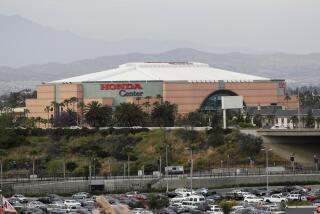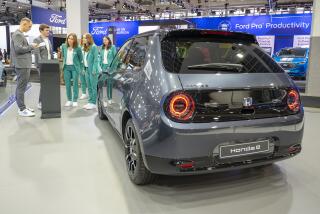Honda: The Americanization of an Auto Maker : Firm’s U.S. Push Moving It Closer and Closer to the Big 3
DETROIT — Honda’s Tetsuo Chino is on the phone from Tokyo, talking about the American presidential campaign, when Democrat Richard Gephardt’s name comes up.
Doesn’t the Missouri congressman’s tough stance on Japanese imports, Chino is asked, worry most Japanese business leaders?
Chino, with years of experience in the United States, laughs.
“He doesn’t worry us,” the Honda executive insists.
Indeed, Chino and other Honda officials may have less reason for concern over the rising tide of protectionist sentiment in Washington than the leaders of any other major Japanese corporation: Honda, which is spending a total of $1.7 billion on a sophisticated U.S. manufacturing complex, is quickly being Americanized.
Today, Honda is the only Japanese auto maker to have expanded its U.S. manufacturing base beyond a simple “transplant” assembly facility using unskilled Americans to put together kits of Japanese-built parts. Instead, Honda has spent hundreds of millions of dollars on U.S. parts plants producing engines, transmissions, brakes and other components--work that all other Japanese auto makers still perform in Japan. As a result, Honda’s Ohio-built Accord and Civic models come equipped with more American parts than any other Japanese car built in the United States.
Independence From Japan
And now, Honda is establishing an even more integrated American product development, engineering and manufacturing operation that could transform the company into an auto maker nearly as American as the Big Three.
In fact, Chino, president of Honda’s North American operations, now vows that Honda’s U.S. arm will soon become a company virtually independent of Japan, one that he pledges will be capable of producing and actually exporting back to Japan U.S.-built cars that carry greater American content than some produced by Chrysler.
To live up to that commitment, Honda is moving hundreds of design and manufacturing engineers from Japan to the United States--and plans to hire several hundred American engineers as well--to give its American operations the technical staff it needs to design and develop a new car here with only marginal input from Japan.
“Our dream is to increase our engineering and product development resources in the United States to establish a self-reliant auto company in America as part of an international organization,” notes Honda spokesman Shinichi Tanaka. “There used to be one major player in Honda--that was Japan. Now, we will have two, Japan and the United States, with both supplying cars worldwide.”
Honda’s moves come in the wake of mounting American criticism of the increasing numbers of Japanese auto plants being built in the United States. Union officials and congressional leaders alike have charged that those plants are little more than hollow shells designed to avert import quotas, assembly operations that produce Japanese-designed cars built with Japanese components. In fact, one of the most controversial, and as yet unresolved, issues facing American and Japanese trade negotiators is the huge trade surplus in auto parts that Japan is running with the United States.
Needs U.S. Market
But while Nissan, Toyota and Mazda still import most of the major components they use in their American assembly operations, Honda has decided to set up a massive manufacturing center around its Marysville, Ohio, assembly plant, investing far more in U.S. production than any of its Japanese rivals.
Honda has become so committed to U.S. manufacturing for one simple reason--without open access to the American market, where it has become the best-selling Japanese nameplate, the company would surely die. Half of the company’s worldwide annual sales of $18 billion and the bulk of its profit come from the United States. Honda now sells far more cars here than it does in its home market of Japan. Toyota, by contrast, is much more dependent on Japan, where it holds an overwhelming lead in domestic car sales.
With so much at stake here, Honda was the first Japanese auto maker to respond to rising trade frictions and tough import quotas when it opened the first Japanese assembly plant in the United States in 1982.
Five years later, California is one of the few major American markets where Honda still relies primarily on imported cars; outside California, 80% of Honda’s four-door Accord and four-door Civic models come from Marysville.
But it was only last month that Honda announced its most ambitious American project yet.
By 1989, the company said, it will open a second U.S. assembly plant in East Liberty, Ohio, not far from Marysville, expanding its U.S. auto-making capacity to 510,000 annually from about 360,000 a year, firmly establishing Honda as the fourth-largest U.S. auto producer, behind Chrysler.
Including a Canadian plant that will produce 80,000 units a year beginning in 1989, Honda’s North American division will thus grow to half the size of its Japanese automotive operations, which produce 1.2 million cars for Japan and worldwide export in two huge assembly plants.
Staffing Up
Meanwhile, Honda will also expand its American parts operations, so that all of the major components for those U.S.-built cars, including their engines and transmissions, will be built in Ohio as well.
Honda also bought a 7,500-acre transportation research center from the state of Ohio, already equipped with a test track and crash-testing laboratory, which the company will use for a research and engineering center. Honda plans to add 500 engineers to its American operations to staff both the Ohio center and a design facility in Los Angeles. Within four years, Honda expects to have 700 product and manufacturing engineers in the United States, compared to a total of 4,000 in Japan.
Most dramatically, the company will also export 3,000 Accord models back to Japan next year and plans to increase worldwide exports from the United States to 70,000 units a year--including 50,000 a year to Japan--by 1991.
The Marysville plant will be converted to produce cars equipped with right-side steering for the Japanese market and left-side drive cars for American drivers, Tanaka said.
When its expansion project is completed, Honda will employ 8,600 American workers in its manufacturing plants, nearly three times as many as Toyota plans to hire for its Kentucky assembly plant, which will open next year.
At the same time, three of every four parts in each of Honda’s U.S.- built cars will be made in America, up from its current U.S. content level of 60%. By contrast, none of the other Japanese cars built in the United States carry more than 50% U.S. content.
But curiously, Honda has never publicized its rapid Americanization in its U.S. advertising campaigns, and, despite mounting trade friction between the United States and Japan, doesn’t plan to start now. Chino seems to think that the company’s huge investment here will speak for itself.
“I don’t think it is necessary for us to advertise it,” insists Chino. “The American public will know about it eventually.”






